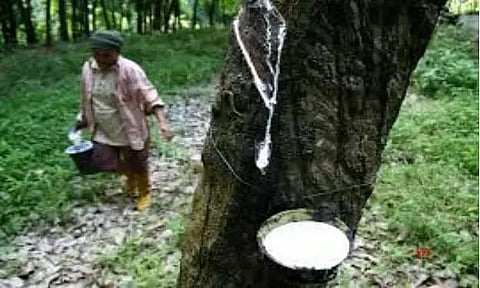

Assam and the other North-eastern states are planning to expand rubber cultivation over the next five years. As India decreases its dependency on its imports, Assam has the potential to become the largest exporter of natural rubber in the Northeast, says ASHIS BISWAS.
——–
WITH Assam and other states in the Northeast set to expand rubber cultivation in a major way during the next five years, India should be able to substantially reduce its dependence on imports.
Encouraged by the slight decrease in imports between 2018 and 2020, experts believe that the production of natural rubber in short term shouldn't be a difficult task.
RUBBER PRODUCTION TODAY
At present only around 57 percent of the demand from rubber-based industries is being met by domestic production. Kerala accounts for the highest production where natural rubber is cultivated over an area of 600,000 hectares. Tripura comes second in terms of cultivation with 85,083 hectares. The state produces around 75.000 tonnes annually. Almost 90 percent is transported to other states, as Tripura does not have any rubber-based industry as yet.
The NDA Government is pushing for fresh plans to rev up rubber cultivation as an important component of the country's Atmanirbhar scheme. The Union Minister for Commerce and Industries, Piyush Goyal, has been urging upon concerned state governments to assign priority to the expansion of rubber-based industries. Around Rs, 1,100 crores will be invested in Assam and the neighbouring states over the next five years to achieve new production targets.
“Following the recent talks with the central Government, the decision was taken to expand existing cultivation levels to cover around 500,000 hectares in the next five years.
In Assam, according to the state Minister for Commerce and Industries Chandramohan Patowary, rubber is being cultivated currently on 60,000 hectares, with an annual production figure of around 32.000 million tonnes. Nearly 200,000 people are engaged in the work, which brings in Rs 430 crore as revenues.
Following recent talks with the central government, the decision was taken to expand existing cultivation levels to cover around 500,000 hectares in the next five years. With the promised funds from the Centre, Assam government officials are confident that the target can be achieved.
If Assam meets its targets then it will overtake Tripura by a long margin to take the title of the most rubber producing state in the Northeast. Kerala would still be ahead in terms of the total area under cultivation and the actual production of natural rubber. The state already leads in the production of high-quality tea which remains a steady export earner.
“If Assam meets its targets then it will overtake Tripura by a long margin to take the title of the most rubber producing state in the Northeast.
To emerge as the second highest producer of natural rubber in the country despite its often unpredictable and turbulent politics would be no mean feat for Assam. It would adequately substantiate the proud claim made by the people of Assam, who describe their native state as a major resource area for the entire country.
RUBBER EXPORTS AND DEVELOPMENT
However, rubber cultivation is equally important for Tripura who until recently was plagued by the prolonged insurgency, in terms of its economic development. The small state earns around Rs 600 crore by way of revenues, and nearly 150,000 families are engaged in the cultivation directly or indirectly.
State officials plan to bring more areas under cultivation, taking advantage of the center's scheme. In the short term, there is a proposal to increase the total acreage under rubber plants to over 100,000 hectares as early as possible.
According to the sources, India imported 6,01,000 tonnes of natural rubber in 2018. It was 4,87,000 tonnes in 2019 and 4,57,000 tonnes in 2020. These imports came mostly from Malaysia, Indonesia, Thailand and Vietnam.
“Growing rubber has economic benefits as well as helps improve our environment.
In terms of weather and other factors, experts maintain that rubber cultivation should have occurred in a bigger way in the South in places such as Karnataka, Odisha, Maharashtra, or Andhra Pradesh, apart from Kerala and Tamil Nadu. The additional benefits of growing natural rubber cannot be forgotten for the soil gets a greener cover and the area gets cleaner air. (IPA Service)
(Ashis Biswas is a Kolkata-based journalist. The views are personal.)